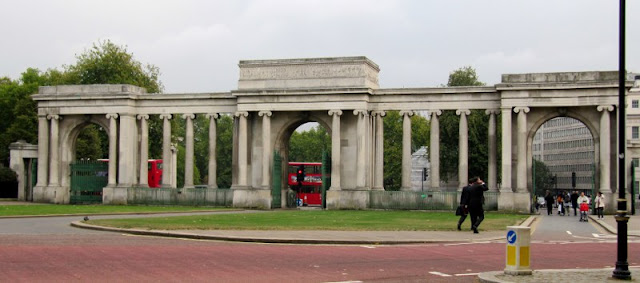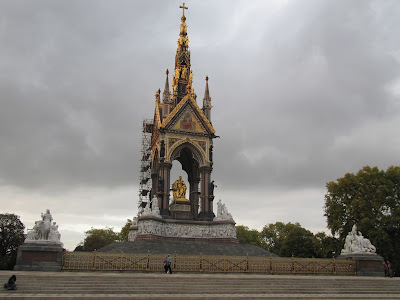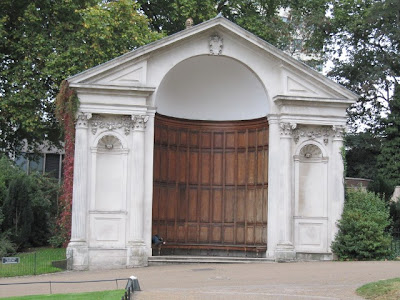Hyde Park and Kensington Gardens together with two other Royal Parks of London, Green Park and St James's Park form an almost continuous "green lung" in the heart of London.
In 1536, Henry VIII acquired the manor of Hyde from the canons of Westminster Abbey and enclosed it as a deer park. It remained a private hunting ground until James I permitted limited access to gentlefolk, and appointing a ranger to take charge. In 1637 Charles I opened the park to the general public.
In 1728 Queen Caroline carved Kensington Gardens out of the western section of Hyde Park. During the next ten years fashionable features including the Round Pond, formal avenues, and a sunken Dutch garden were added.
 |
| Serpentine Bridge |
The Serpentine was created by damming the eastern outflow of the River Westbourne. The Serpentine is divided by a bridge, and the part of the Serpentine that lies within Kensington Gardens is known as The Long Water.
Kensington Gardens are fenced and more formal than Hyde Park. West Carriage Drive (The Ring) and the Serpentine Bridge form the boundary between Hyde Park and Kensington Gardens.
Hyde Park was the site of The Great Exhibition of 1851, for which the Crystal Palace was designed by Joseph Paxton. The Crystal Palace was constructed on the south side of the park, between Rotten Row and West Carriage Drive, where the Hyde Park Tennis Centre and the Old Football Pitches stand today (see map). After the exhibition, the Crystal Palace was moved to Sydenham Hill in South London.
 |
| Marble Arch front and rear |
Marble Arch was designed in 1825 by John Nash as a ceremonial entrance to the new Buckingham Palace. It was completed in 1833, and in 1851 it was moved to its present location. There are three small rooms inside the rebuilt arch that were used as a police station until 1950, first for the royal constables of the Park and later the Metropolitan Police.
 |
| Speakers' Corner looking towards Marble Arch |
The park has become a traditional location for mass demonstrations. The Chartists, the Reform League, and the Suffragettes have all held protests in the park. An Act of Parliament passed in 1872 (The Royal Parks and Gardens Regulation Act) allowed a space in the north-eastern corner of Hyde Park to be given over for public speaking.
 |
| Achilles Statue |
The Achilles Statue by Richard Westmacott was erected in 1822. It has a dedication "To Arthur, Duke of Wellington, and his brave companions in arms."
 |
| Grand Entrance |
The Grand Entrance to Hyde Park was built from the designs of Decimus Burton in 1824–25. It's front is around 33m long.
 |
| Apsley House |
Apsley House stands alone near the Grand Entrance at Hyde Park Corner, on the south-east corner of Hyde Park. It is perhaps the only preserved example of an English aristocratic town house from its period.
The house was originally built in red brick by Robert Adam between 1771 and 1778 for Lord Apsley, the Lord Chancellor. In 1807 the house was purchased by Richard Wellesley, 1st Marquess Wellesley, the elder brother of Sir Arthur Wellesley, but in 1817 financial difficulties forced him to sell it to his famous brother, by then the Duke of Wellington, who needed a London base from which to pursue his new career in politics.
Wellington employed the architect Benjamin Dean Wyatt to carry out renovations between 1818 and 1819. He extended the house by adding two bays westward to the original five; built the Waterloo Gallery for the Duke's paintings, and faced the red brick with the grander golden Bath stone.
 |
| Italian Garden (being renovated) |
The Italian Garden is an ornamental water garden with four fountains, and classical sculptures. It was inspired by Queen Victoria's husband, Prince Albert, and created in 1860-1.
 |
| Albert Memorial |
The Albert Memorial is situated directly to the north of the Royal Albert Hall. It was commissioned by Queen Victoria in memory of her beloved husband, Prince Albert who died of typhoid in 1861.
The memorial was designed by Sir George Gilbert Scott in the Gothic Revival style. It was opened in July 1872 by Queen Victoria, with the statue of Albert ceremonially seated in 1875. The memorial is 54 m tall, and took over ten years to complete.
Part II of this article series - St James's Park and Green Park




No comments:
Post a Comment